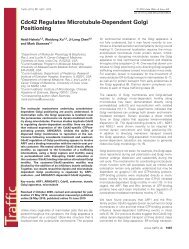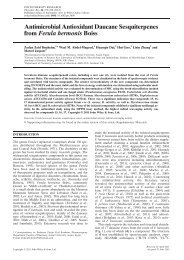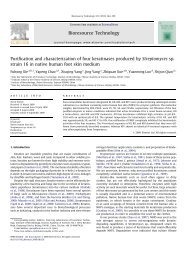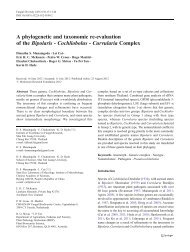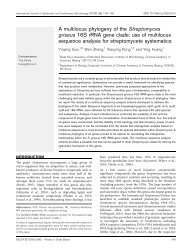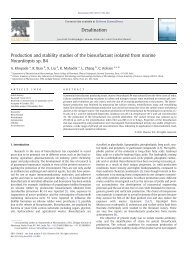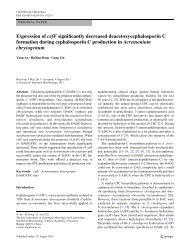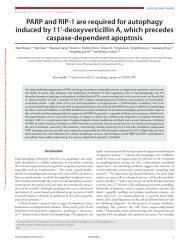Biochemical and structural characterization of Cren7, a novel ...
Biochemical and structural characterization of Cren7, a novel ...
Biochemical and structural characterization of Cren7, a novel ...
You also want an ePaper? Increase the reach of your titles
YUMPU automatically turns print PDFs into web optimized ePapers that Google loves.
1134 Nucleic Acids Research, 2008, Vol. 36, No. 4<br />
Figure 4. Overall solution structure <strong>of</strong> S. solfataricus <strong>Cren7</strong>.<br />
(A) Ribbon representation <strong>of</strong> 20 <strong>Cren7</strong> solution structures. The backbone<br />
<strong>of</strong> five b-str<strong>and</strong>s are shown in green <strong>and</strong> labeled. (B) Molecular<br />
surface <strong>of</strong> <strong>Cren7</strong> colored by electrostatic potential. Blue, positively<br />
charged; red, negatively charged; white, neutral. Some charged or<br />
hydrophobic residues on the molecular surface are labeled. A ribbon<br />
representation is also shown for reference. (C) Structure alignment<br />
<strong>of</strong> <strong>Cren7</strong> (in green) <strong>and</strong> Sac7d (in red, PDB code: 1AZP) by SSM.<br />
(D) Molecular surface <strong>of</strong> Sac7d colored by electrostatic potential. For<br />
comparison, the Sac7d protein is aligned in the same orientation as<br />
<strong>Cren7</strong> in Figure 4B.<br />
b-str<strong>and</strong>s (b3: 24–28, b4: 36–42, <strong>and</strong> b5: 49–53)<br />
(Figure 4A). The side-chains <strong>of</strong> hydrophobic residues V8,<br />
V10, A18, L20, V25, F41 <strong>and</strong> F50 <strong>of</strong> the five b-str<strong>and</strong>s<br />
make a tight packing within the ‘b-barrel’. The C-terminal<br />
region (L54-I60) also participates in the hydrophobic<br />
packing through residues L54 <strong>and</strong> Y58 <strong>and</strong>, therefore, is<br />
<strong>structural</strong>ly ordered. On the other h<strong>and</strong>, the N-terminal<br />
region (M1-K6) <strong>of</strong> the protein is unstructured. Among the<br />
four loops linking the five b-str<strong>and</strong>s, loop L b3b4 (A29-G35)<br />
is most flexible. These <strong>structural</strong> features <strong>of</strong> the protein are<br />
supported by dynamic data (Supplementary Data <strong>and</strong><br />
Supplementary Figure S4). Side chains <strong>of</strong> L28 in b3, V36<br />
<strong>and</strong> I38 in b4 <strong>and</strong> P30 in loop L b3b4 form a notable solventexposed<br />
hydrophobic region (Figure 4B). Side chains <strong>of</strong><br />
K11, K24, K48, R51 <strong>and</strong> K53 from the b-str<strong>and</strong>s, <strong>and</strong> K31<br />
<strong>and</strong> R33 from loop L b3b4 face outside <strong>of</strong> the ‘b-barrel’,<br />
forming a positively charged region on the electrostatic<br />
surface <strong>of</strong> the protein (Figure 4B). Most <strong>of</strong> these residues<br />
are highly conserved, indicating that proteins <strong>of</strong> the <strong>Cren7</strong><br />
family have similar structures as well as surface charge<br />
distributions (Figure 1B).<br />
DNA-binding surface <strong>of</strong> <strong>Cren7</strong> was determined by<br />
monitoring signal changes in two-dimensional<br />
1 H- 15 N<br />
HSQC spectra following titration <strong>of</strong> the protein with a<br />
10-bp duplex DNA (Supplementary Figure S5). As the<br />
DNA was titrated into the mixture, changes were observed<br />
for the cross peaks <strong>of</strong> residues involved in DNA binding.<br />
No further changes in the HSQC spectra occurred at<br />
DNA/protein molar ratios >1, suggesting a stoichiometry<br />
<strong>of</strong> one for the <strong>Cren7</strong>–dsDNA complex (Supplementary<br />
Data). Approximately one-third <strong>of</strong> the residues in <strong>Cren7</strong><br />
showed significant chemical shift changes in the HSQC<br />
spectra during dsDNA titration, indicating the presence <strong>of</strong><br />
a large DNA-binding surface on the protein. In addition<br />
to the chemical shift changes, two cross peaks for side<br />
chains <strong>of</strong> R33 (on loop L b3b4 ) <strong>and</strong> R51 (in b5), which were<br />
not observed in the HSQC spectrum <strong>of</strong> free protein<br />
because <strong>of</strong> amide-water proton exchange, appeared in the<br />
spectrum at the saturating level <strong>of</strong> dsDNA. Therefore,<br />
the two Arg residues are located at the binding interface <strong>of</strong><br />
the protein–DNA interaction, <strong>and</strong> the amide-water proton<br />
exchange was prevented by bound dsDNA. The binding<br />
surface, as obtained by mapping these residues on the<br />
structure <strong>of</strong> <strong>Cren7</strong>, spans residues on str<strong>and</strong>s b3, b4, b5,<br />
the C-terminus <strong>of</strong> b1 <strong>and</strong> loop L b3b4 (Figure 5A–C).<br />
It consists mainly <strong>of</strong> the positively charged surface region<br />
<strong>and</strong> the solvent-exposed hydrophobic region. It was noted<br />
that the conformational flexibility <strong>of</strong> loop L b3b4 was<br />
significantly reduced upon binding <strong>of</strong> the protein to DNA,<br />
as evidenced by a significant increase in 1 H- 15 N NOE<br />
value (Supplementary Figure S4).<br />
Dali <strong>and</strong> SSM searches show that the structure <strong>of</strong><br />
<strong>Cren7</strong> is a SH3-like fold. Although this fold was originally<br />
identified in proteins that bind poly-proline peptides,<br />
it has since been found in proteins with a number <strong>of</strong><br />
other functions (29,30). A typical SH3 fold contains five<br />
b-str<strong>and</strong>s <strong>and</strong> a short 3 10 -helix between b4 <strong>and</strong> b5. <strong>Cren7</strong><br />
lacks both the C-terminal b5 <strong>and</strong> the 3 10 -helix, but has<br />
a structured loop at the C-terminus. The other b-str<strong>and</strong>s<br />
<strong>of</strong> <strong>Cren7</strong> are similar to SH3, except that the b2 found in a<br />
typical SH3 fold is split into two sequential b-str<strong>and</strong>s<br />
in <strong>Cren7</strong>. Interestingly, Sac7d, a Sul7d protein from<br />
Sulfolobus acidocaldarius, is the most relevant hit among<br />
those identified SH3-like proteins in the searches although<br />
the two proteins share no significant similarity at the<br />
amino-acid sequence level. The RMSD between <strong>Cren7</strong><br />
<strong>and</strong> Sac7d aligned by Dali is 2.6 A˚ (with a Z-score <strong>of</strong> 2.8),<br />
indicating a high <strong>structural</strong> similarity between the two<br />
proteins. Among 60 residues in <strong>Cren7</strong> <strong>and</strong> 66 residues in<br />
Sac7d, 44 are <strong>structural</strong>ly aligned by Dali. The ‘b-barrel’<br />
parts <strong>of</strong> the two proteins are aligned best (Figures 4C<br />
<strong>and</strong> 5A). The two proteins also have similar solventexposed<br />
hydrophobic regions <strong>and</strong> positively charged<br />
regions on b-sheet 2, which form the DNA-binding<br />
surfaces (Figure 4B <strong>and</strong> C). A number <strong>of</strong> residues on the<br />
DNA-binding surfaces <strong>of</strong> the two proteins are conserved<br />
or similar. These include positively charged residues (K11,<br />
K24 <strong>and</strong> R51), hydrophobic residues (L28, V36 <strong>and</strong> L40)<br />
<strong>and</strong> a tryptophan residue (W26) in <strong>Cren7</strong> (Figure 5D<br />
<strong>and</strong> E). However, several notable <strong>structural</strong> differences<br />
exist between <strong>Cren7</strong> <strong>and</strong> Sac7d. At the DNA-binding<br />
surface, <strong>Cren7</strong> has a long <strong>and</strong> highly flexible loop (L b3b4 ),<br />
whereas only a small hinge exists at the corresponding<br />
position in Sac7d. In addition, the solvent-exposed hydrophobic<br />
region <strong>of</strong> <strong>Cren7</strong> (L28, P30, V36, I38) is larger than<br />
that <strong>of</strong> Sul7d (V26, M29). <strong>Cren7</strong> has a flexible N-terminal





